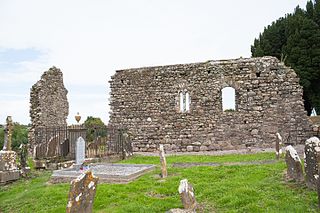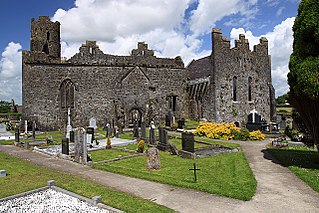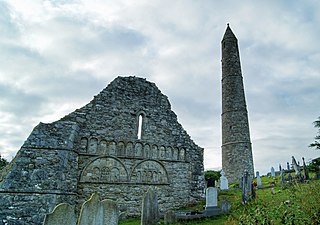
New Ross is a town in southwest County Wexford, Ireland. It is located on the River Barrow, near the border with County Kilkenny, and is around 20 kilometres (12 mi) northeast of Waterford. In 2022 it had a population of 8,610 people, making it the fourth-largest town in the county.

Ferns is a historic town in north County Wexford, Ireland. It is 11 km (7 mi) north of Enniscorthy. The remains of Ferns Castle are in the centre of the town. The town is in a civil parish of the same name.

Kilcrea Friary is a ruined medieval abbey located near Ovens, County Cork, Ireland. Both the friary and Kilcrea Castle, located in ruin to the west, were built by Observant Franciscans in the mid 15th century under the invitation of Cormac Láidir MacCarthy, Lord of Muskerry, as protection from English troops.

The Crutched Friars were a Roman Catholic religious order in England and Ireland. Their name is derived from a staff they carried with them surmounted by a crucifix. There were several orders devoted to the Holy Cross, collectively known as Crosiers, that had some presence in England and there is much confusion to which specific order the friars belonged. Earlier literature linked most of the Crutched Friars to the Italian Crosiers, but later it was proven that they were a branch of the Belgian Canons Regular of the Order of the Holy Cross. The Crutched Friars were suppressed during the Dissolution of the Monasteries in 1538.

A monastery was founded by St Laiseran before 640 on the site of the present ruins of the medieval Old Priory at the junction of High Street, Victoria Road and the Old Bangor Road in Holywood, County Down. The present ruins are late 12th / early 13th century Anglo-Norman Augustinian Abbey built by Thomas Whyte and much of these ruins remain as the fabric of the structure. The church consists of a nave & chancel without structural division, 22.5m x 6m internally, with a West tower. The original building is late 12th / early 13th century & entered on South. In the 15th century, the West end was rebuilt with a new entrance & the East window replaced. The upper levels of the tower were added in 18th century. Some of the masonry is 'Cultra Stone' ashlar and red sandstone. The Cultra Stone is also used for masonry dressings at Ardkeen and Ballywalter churches as well as other churches in the wider Ards area.

Clonmines is a civil parish and townland in the Bannow Bay area of County Wexford, Ireland, the site of "the finest example in Ireland of a deserted medieval borough". It is situated in the barony of Shelburne, southwest of Wellingtonbridge on the northwest shore of Bannow Bay. The parish of Clonmines contains the townland of the same name and the smaller townland of Arklow, with respective areas of 1,258 acres (509 ha) and 127 acres (51 ha).

Thomastown Church is a medieval church and National Monument in County Kilkenny, Ireland.

St. Francis Abbey, also called Kilkenny Grey Friary, is a medieval Franciscan abbey and National Monument located in Kilkenny City, Ireland.

St John's Priory, is a medieval Augustinian priory and National Monument located in Kilkenny City, Ireland. The Lady Chapel of the priory is now used as a parish church of the Church of Ireland.

Clone Church is a Romanesque medieval church and National Monument in County Wexford, Ireland.

Mothel Abbey is a former Augustinian monastery and National Monument located in County Waterford, Ireland.

St. Molua's Church, Killaloe is a medieval church and National Monument in Killaloe, Ireland.

The Priory of St. Mary in Cahir, known as Cahir Abbey, was a medieval priory of Augustinian Canons regular and is a National Monument located in Cahir, Ireland.

The Collegiate Church of St Peter and St Paul is a medieval collegiate church and a National Monument in Kilmallock, Ireland. The church is believed to have been built on the site of an ancient monastery.

The Priory of Saint Mary, Clontuskert-Hy-Many, also called Clontuskert Abbey, is a medieval Augustinian priory and National Monument located in County Galway, Ireland.

Donaghcumper Church is a ruined medieval church in Celbridge, Ireland. On the Record of Monuments and Places it bears the code KD011-013.

Askeaton Abbey or Askeaton Friary is a ruined medieval Franciscan friary located north of Askeaton, County Limerick, Ireland, on the east bank of the River Deel.

St. Declan's Monastery, containing the remains of Ardmore Cathedral, is a former monastery and National Monument located in County Waterford, Ireland.

Killashee Round Tower is an Irish round tower that forms part of the monastic remnants of Killashee, County Kildare, Ireland. On the Record of Monuments and Places its number is KD024-003.

St Saviour's Priory is a ruined Augustinian monastery in Glendalough, County Wicklow, Ireland.






















